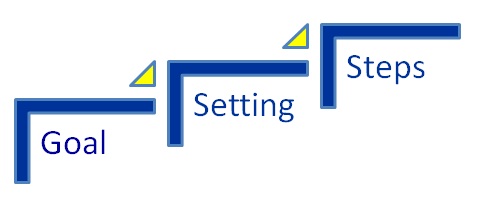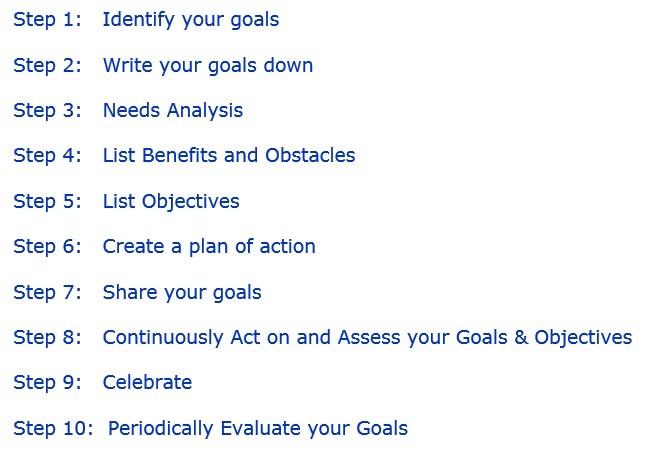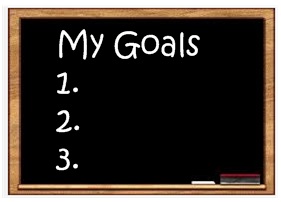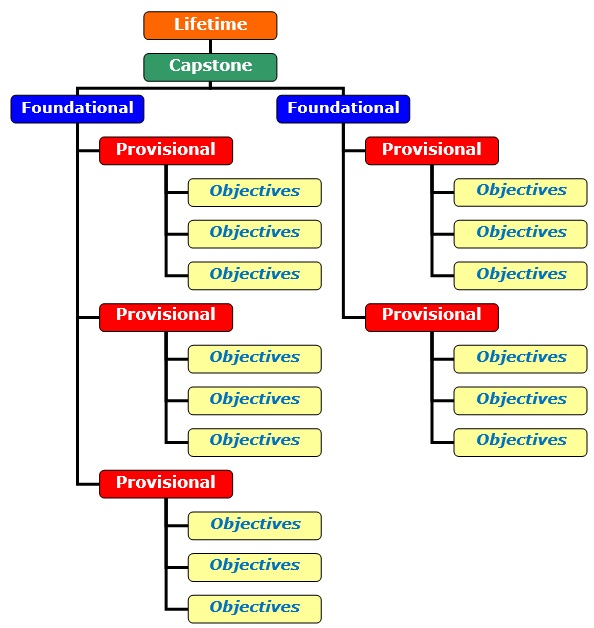10 STEPS TO GOAL SETTING
Step 1 – Identify your goals
By knowing precisely what you want to achieve, you know what you have to concentrate on and improve. When there is a target, people feel driven to meet it.
Decide specifically what it is you want. Identify, as goals, two things you want to accomplish this year.
Keep in mind; a persons’ reach should exceed one’s grasp. In other words, set goals that will be challenging to reach.
Answer the following questions to help you set some goals.
- What do I want to accomplish in the upcoming years?
- What are some thing that I find interesting?
- What are some things that I really like to do?
- Are there one of these things that I would like to learn more about or learn to do better?
- Are there completely new things that I want to learn to do?
“Your goals are the road maps that guide you and show you what is possible for your life.” Les Brown
Step 2 – Write your goals down
Writing down your goals turns them from wishes into realities, and is the first step in committing to the goal. When you put pen to paper you turn your thoughts into something tangible.
Writing down your Dreams and Goals is an important first step towards achieving them. First, because by writing them down it forces you visualize your Goals. And second, because the act of writing them down creates a commitment on your part. Only about 5% of the population actually takes the time to write down their Goals and Dreams.
Write your goals down in precise, positive statements. The best goals are fully defined visions of how you want things to be. The more specific, measurable, and challenging the goals are the more motivated people will be in attaining them. Set a deadline for the achievement. Put a date on it.
Determine a deadline for accomplishment. A goal must have a deadline. If you do not have a date on it, the goal is only a wish or a dream. Decide what you want to accomplish. The goal should be very specific. If you want to close more sales, how many more sales do you want to close? What do you want your closing ratio to be? If you want to move into a different job, what are the characteristics of that job? Determine that the goal is believable to you. You must feel that the goal can be realized. If you believe it is impossible to achieve, you will never take the action necessary to make the goal a reality.
A basic goal has these five elements:
1. They are expressed with action verbs.
2. They are written in specific language.
3. They specify measurable results.
4. They challenge you without being unreachable.
5. They specify completion dates.
Examples of basic goals:
| ACTION | SPECIFIC MEASURABLE RESULT | TIMETABLE |
| I want to learn | to play four songs on the piano | by the recital |
| I want to run | the entire 5k race | On June 1 |
| I want to paint | my living room and dining room | before Christmas |
Also:
- Write your goal in the positive
- Write your goals out in complete detail
- Write in present tense
Give your goal the “control test.” Do you have control over what you want to do? Does the action part of your goal tell what you will do? You have control over a goal such as “I will learn to identify ten kinds of trees on my property this fall.” However, if the action mentioned in the goal is what someone else will do, it does not pass the control test. The goal statement, “I will win the first place trophy at the horse show,” does not pass the control test because the judge provides the action that decides who will win the high point trophy. Do your goals pass the control test?
When the words are written and then repeatedly re-written they have maximum impact.
“I feel that the most important step in any major accomplishment is setting a specific goal. This enables you to keep your mind focused on your goal and off the many obstacles that will arise when you’re striving to do your best.” Kurt Thomas
Step 3 – Needs Analysis
After you identify each goal, think about what you need to do to reach your goal. Where are you now? Take a current inventory. You will never know how far you have to go if you do not know where you already are. Do you need to read or do research about something? Do you need to learn a special skill to meet your goal? How much practice will it take? Also think about who will help you reach your goals. Identify all the skills, information, knowledge, resources, and help from people and organizations that you will need to achieve your goals, and the people with whom you will need to collaborate.
Think about what skills and knowledge you will need to reach your goals.
- How good am I already at these things?
- How much do I know about this already?
- What skills do you need to achieve this goal? (Skills are things you physically do such as throwing a baseball and hitting a baseball).
- What information and knowledge do you need? Knowledge is using your brain like knowing how to throw a curve ball.
- What resources do you need?
- What help, assistance, or collaboration do you need?
When you are thinking about how to achieve goals, focus on the sub-goals that lead to their achievement:
- List the skills required to reach your goal.
- List the knowledge required to reach your goal.
- Identify the people and groups you need to work with to reach your goal.
- List the resources you need to reach your goal.
Step 4 – List Benefits and Obstacles
Make a list of the benefits you will receive from attaining your goal. By creating a list of benefits you become more intrinsically motivated to achieve your goals.
Make a list of anticipated obstacles. List the obstacles to overcome in accomplishing your goal.
- What can block my progress?
- Am I making any assumptions?
If you are aware of the obstacle you can make plans to overcome it.
“You measure the size of the accomplishment by the obstacles you had to overcome to reach your goals.” Booker T. Washington
Step 5 – List Objectives
You will need to break things down into smaller tasks.
- Objectives let you track your progress more efficiently
- Objectives are not so overwhelming
- Objectives are easier to achieve
- Objectives let you feel the progress
Objectives are the practical steps needed to help you achieve your goal.
Goals have a deadline. They are broken down into steps, with each step having its own deadline. When all of the separate deadlines are reached, the overall goal has been achieved.
Possible objectives for provisional goal of Painting House:
- Determine the best paint
- Determine color
- Determine the most efficient way to paint (brush, spray, etc…)
- Create list of supplies
- Obtain supplies (paint, brushes, drop cloth, etc…)
- Scrape old paint
- Apply primer
- Apply paint
“Great things are not done by impulse, but by a series of small things brought together.” Vincent Van Gogh
Step 6 – Create a plan of action
Develop a plan of action to complete each objective and reach your goal.
Set up a time frame for your goals and objectives. Break each stage into basic tasks. List the primary things that need to be done first.
A person may have a list of objectives that they want to achieve on a Saturday. They would create an action plan on how they would accomplish those objectives.
Develop an action plan. Determine the specific steps that will be necessary to achieve the goal. Start at the accomplishment of the goal and work backwards.
Action plan for provisional goal of Painting House:
Action Plan
Monday
- Determine the most efficient way to paint (brush, spray, etc…) by using the internet to research.
- Complete a cost benefit analysis for the most efficient way to paint
Tuesday
- Determine the best paint by using the internet and asking professionals
- Determine color
- Find a local distributor who sells that particular paint
Wednesday
- Create list of supplies with the store they can be obtained at
Thursday
- Obtain supplies (paint, brushes, drop cloth, etc…)
- Pick up power wash at rental company
Friday
- Scrape old paint using scraper and power wash
- Apply primer to exposed areas
Saturday
- Apply paint to entire house (except trim)
Sunday
- Apply paint to trim
Step 7 – Share your goals
Talk about your goals with another. Share them with your friends and your family. When we talk to others about our goals, it helps us get a better idea of what we are going to do.
Post your goals where you and others can see them.
“The moment of enlightenment is when a person’s dreams of possibilities become images of probabilities.” Vic Braden
Step 8 – Continuously Act on and Assess your Goals and Objectives
Take daily action towards the goal. Goals are evolving and changing things that need to be revisited and revised constantly. Therefore, you should assess your progress on a regular basis. Work in a systematic way to review, modify and up-date your objectives constantly.
A football coach would assess the performance of their team throughout the first half and then make some adjustments at halftime. The coach would then reassess the team during the second half and make some potential adjustments for the next game.
Take daily action towards the goal. Dreams and goals require action. The best goal in the world will never materialize unless consistent action is taken.
“We will either find a way, or make one!” Hannibal
Step 9 – Celebrate
The most important thing is to recognize your progress and your success, and to celebrate them.
Reward yourself for your successes. Once you have made progress toward or reached your goal, you should celebrate and be proud of what you have accomplished. Every now and then, think about how you feel about your progress. Sometimes goals are hard to stick to. It takes a long time to see results. So as you complete a step and meet a deadline you need to give yourself a boost or energizer.
“What you get by achieving your goals is not as important as what you become by achieving your goals.” Zig Ziglar
Step 10 – Periodically Evaluate your Goals
Periodically, take some time to review your entire goal list and evaluate your progress. Use your failures as lessons for planning future successes.
Goals do not occur in isolation. We have many different goals in our lives, and we need to figure out how to set priorities and still reach our different goals.
Although you have assessed your goals on a constant basis, you must also take some time to evaluate your goals and your progress. Assessing entails making small adjustments to your objectives. Evaluating your goal entails reviewing your entire goal to ensure you are heading in the right direction, need to adjust time frames, or if you no longer have this goal in your life.
A football coach assesses his team’s performance during their games, however it is important for a coach to sit down and evaluate the overall performance of the team and potentially make some significant changes. He may redesign the defense or add new plays.
As you evaluate your goals, you will make changes based on your experience and your circumstances. Your failures will provide valuable lessons for future goal setting.
You may need to:
- Make your goals more challenging
- Make your goals easier to accomplish in a shorter time
- Seize new opportunities
- Improve your deficiencies – maybe you will need to acquire more knowledge and skills
To help you analyze your goals, it is important to ask yourself two questions
1. Do I have any goals that are in conflict? Will pursuing one goal prevent or make it difficult to reach another one?
2. Am I committed to my goals?
If one of your goals is to earn a six-figure income and another one is to get a degree in social work.
You may want to run a marathon, but unless you are willing to invest the time and energy to train and prepare properly, you are not committed to it.
“Go confidently in the direction of your dreams. Live the life you’ve imagined.” Henry David Thoreau





